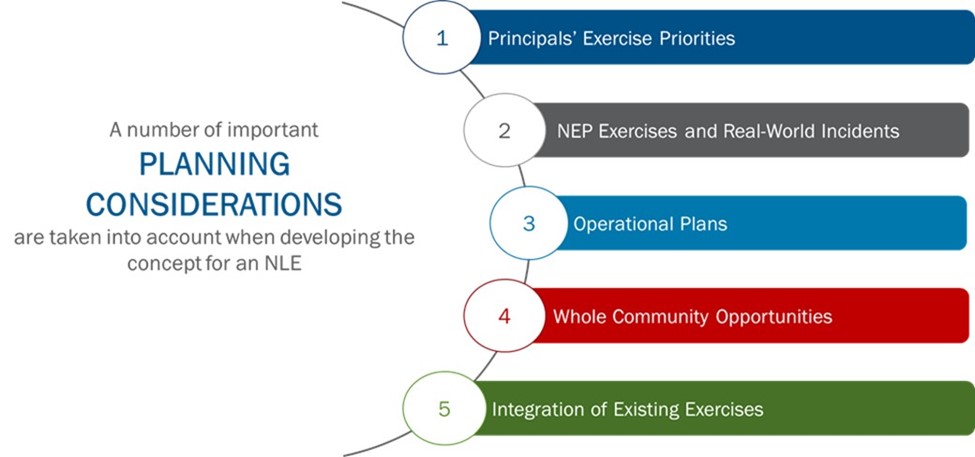The Post-Katrina Emergency Management Reform Act (PKEMRA) of 2006 addressed the shortfalls in the preparation for and response to Hurricane Katrina by more clearly defining the agency’s role in emergency management. PKEMRA also mandated the President to establish and maintain a National Preparedness Goal and National Preparedness System to better prevent, respond to, recover from, and mitigate against disasters of all kinds, including acts of terrorism.
As a key component of the National Preparedness System and the National Exercise Program (NEP), the National Level Exercise (NLE) is congressionally mandated in PKEMRA, which states that:
“the Administrator [of FEMA] shall periodically, but not less than biennially, perform national exercises . . . to test and evaluate the capability of Federal, State, Local and Tribal governments to detect, disrupt and prevent threatened or actual catastrophic acts of terrorism, especially those involving weapons of mass destruction,” and “to test and evaluate the readiness of Federal, State, local, and tribal governments to respond and recover in a coordinated and unified manner to catastrophic incidents.” (United States Code, Title 6, Chapter 2, Subchapter II, Part A, Section 748(b)(3).)
NLEs Promote and Sustain a Prepared Nation
The National Level Exercise program provides many opportunities for individuals, families, and communities to participate and better prepare for disasters of all sizes and scopes. These exercises provide the tools to promote preparedness through many channels.
Based on Real-World Incidents
National Level Exercises build upon real-world incidents to make sure that our nation is better prepared when the next disaster strikes. For example, cybersecurity workshops conducted in advance of National Level Exercise 2020 leveraged lessons learned from real-world cybersecurity incidents to share with federal, state, local and private sector partners across the country.
In addition, the exceptionally active 2017 Atlantic hurricane season highlighted the importance of working together before, during, and after disasters. Therefore, National Level Exercise 2018 examined the ability of all levels of government, private industry, and nongovernmental organizations to prepare for, respond to, and recover from a major Mid-Atlantic hurricane. FEMA leveraged the National Level Exercise and its participating organizations as an opportunity to amplify the hurricane preparedness message to individuals, businesses, and community organizations in advance of the 2018 Atlantic hurricane season.
These are just a few ways that the National Level Exercise program has been used to promote and sustain a prepared nation.
Whole Community Participation and Partnerships
National Level Exercises support whole community participation and partnerships throughout the nation with the involvement of all levels of government, private industries, nongovernmental organizations, and individuals. When it comes to keeping our nation safe, everyone plays a vital role. Participating in National Level Exercises gives you and your organization the platform to collaborate on ways to better prepare for disasters in your community.
National Level Exercises aren’t just for government departments and agencies. In fact, some of our most valuable stakeholders are private sector and community organizations that have direct access to individuals through their customer bases or memberships. Voluntary organizations are also valued partners because of the pivotal role they play in supporting critical lifelines during emergency response. It is crucial that these types of organizations get the opportunity to exercise the roles they would play in a real-world incident.
Above all, National Level Exercises help us develop preparedness practices for all citizens, across all sectors and levels of government.
Selection and Timeline
Similar to the timing of the summer and winter Olympics, National Level Exercises alternate between scenarios focused on adversary threats and natural disasters every two years in order to allow the nation to build capability across both types of threats to our country.
A number of important planning considerations are taken into account when developing the concept for an NLE.

The NLE is a national-level mechanism for validating core capabilities and operational plans across all mission areas. Each NLE is guided by Principals' Exercise Priorities (PEPs), which are set by the Principals Committee of the National Security Council and driven by national preparedness data.
To maximize participation in the NLE, FEMA’s National Exercise Division (NED) begins NLE planning no later than two years prior to the subsequent NLE, with additional NLE concept discussions occurring up to four years prior to conduct. This approach allows all levels of government as well as private sector and non-profit partners to budget for participation through their established budget cycles. Such advance planning also allows for operational plans to guide NLE development, ensuring the exercise is tied to validating plans and capabilities, as intended.


